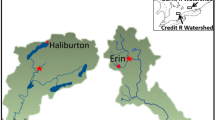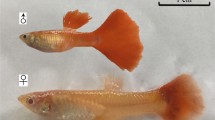Abstract
In developing bioassays for estrogenic effects, vitellogenin (Vtg) induction and zona radiata protein (Zr-protein) induction in males and juveniles of oviparous vertebrates have been used as sensitive biomarkers for estrogenicity. Nonylphenol (NP) produces similar and parallel expression patterns of Vtg and Zr-protein levels in plasma and surface mucus of salmon, the response being concentration- and time-dependent. We have explored the potential mechanisms of Vtg and Zr-protein expression in surface mucus by comparative molecular and cellular approaches. Liver, skin, blood, and surface mucus samples were collected from fish exposed to a single waterborne concentration of NP (10 and 60 μg/l), 3, 7, and 10 days post-exposure, for gene expression analysis (liver and skin; quantitative real-time polymerase chain reaction) and protein analysis (blood and surface mucus; enzyme-linked immunosorbent assay). Protein expression was localized by immunohistochemistry. NP produced concentration- and time-dependent increases of hepatic estrogen receptors (ERα and ERβ), Vtg, and Zr-protein mRNA and plasma protein levels. These responses paralleled cellular detection of Vtg and Zr-protein in the liver with unique expression patterns in the cytoplasm of hepatocytes, hepatic sinusoids, and endothelial cells. ERα, Vtg, and Zr-protein mRNA were detectable in the skin. ERβ was the only skin response that was NP-concentration-dependent, especially at day 10 post-exposure. Immunohistochemistry for Vtg and Zr-protein in skin showed unique expression patterns in mucus vacuoles, epidermal cells, and scales in an NP-concentration- and time-specific manner. Thus, analysis of skin mRNA levels for xenoestrogen biomarker responses is a less-promising approach than protein analysis. The immunohistochemical localization of Vtg and Zr-protein levels in the skin further validates surface mucus as a sensitive biomarker source for estrogenic compounds. These responses represent an improvement for the detection of endocrine-disrupting compounds and related pollutants in the environment.







Similar content being viewed by others
References
Ahel M, Giger W, Koch M (1994a) Behaviour of alkylphenol polyethoxylate surfacants in the aquatic environment. I. Occurrence and transformation in sewage treatment. Water Res 28:1131–1142
Ahel M, Giger W, Schaffner C (1994b) Behaviour of alkylphenol polyethoxylate surfacants in the aquatic environment. II. Occurrence and biotransformation in rivers. Water Res 28:1143–1152
Arukwe A (2006) Toxicological housekeeping genes: do they really keep the house? Environ Sci Technol 40:7944–7949
Arukwe A, Knudsen FR, Goksoyr A (1997) Fish zona radiata (eggshell) protein: a sensitive biomarker for environmental estrogens. Environ Health Perspect 105:418–422
Arukwe A, Nilsen BM, Berg K, Goksoyr A (1999) Immunohistochemical analysis of the vitellogenin response in the liver of Atlantic salmon exposed to environmental oestrogens. Biomarkers 4:373–380
Cheshenko K, Pakdel F, Segner H, Kah O, Eggen RI (2007) Interference of endocrine disrupting chemicals with aromatase CYP19 expression or activity, and consequences for reproduction of teleost fish. Gen Comp Endocrinol (in press)
Chirgwin JM, Przybyla AE, MacDonald RJ, Rutter WJ (1979) Isolation of biologically active ribonucleic acid from sources enriched in ribonuclease. Biochemistry 18:5294–5299
Chomczynski P, Sacchi N (1987) Single-step method of RNA isolation by acid guanidinium thiocyanate-phenol-chloroform extraction. Anal Biochem 162:156–159
Cserhati T (1995) Alkyl ethoxylated and alkylphenol ethoxylated nonionic surfactants: interaction with bioactive compounds and biological effects. Environ Health Perspect 103:358–364
Flouriot G, Pakdel F, Ducouret B, Valotaire Y (1995) Influence of xenobiotics on rainbow trout liver estrogen receptor and vitellogenin gene expression. J Mol Endocrinol 15:143–151
Folmar LC, Gardner GR, Schreibman MP, Magliulo-Cepriano L, Mills LJ, Zaroogian G, Gutjahr-Gobell R, Haebler R, Horowitz DB, Denslow ND (2001) Vitellogenin-induced pathology in male summer flounder (Paralichthys dentatus). Aquat Toxicol 51:431–441
Fossi MC (1994) Nondestructive biomarkers in ecotoxicology. Environ Health Perspect 102:49–54
Fossi MC, Marsili L, Leonzio C, Focardi S (1992) The hazard assessment of cetaceans by the use of a non destructive biomarker in skin biopsy. CCAMLR Sci Abstr 92/47:21
Fossi MC, Casini S, Marsili L (1999) Nondestructive biomarkers of exposure to endocrine disrupting chemicals in endangered species of wildlife. Chemosphere 39:1273–1285
Gale WL, Patino R, Maule AG (2004) Interaction of xenobiotics with estrogen receptors alpha and beta and a putative plasma sex hormone-binding globulin from channel catfish (Ictalurus punctatus). Gen Comp Endocrinol 136:338–345
Golden RJ, Noller KL, Titus-Ernstoff L, Kaufman RH, Mittendorf R, Stillman R, Reese EA (1998) Environmental endocrine modulators and human health: an assessment of the biological evidence. Crit Rev Toxicol 28:109–227
Henderson RF, Bechtold WE, Bond JA, Sun JD (1989) The use of biological markers in toxicology. Toxicology 20:65–82
Herman RL, Kincaid HL (1988) Pathological effects of orally administered estradiol to rainbow trout. Aquaculture 72:165–172
Hill RL Jr, Janz DM (2003) Developmental estrogenic exposure in zebrafish (Danio rerio). I. Effects on sex ratio and breeding success. Aquat Toxicol 63:417–429
Huggett RJ, Kimerle RA, Mehrle PM Jr, Bergman HL (1992) Biomarkers: biochemical, physiological, and histological markers of antropogenic stress. Lewis, Chelsea, Mich., USA
Hutchinson TH, Ankley GT, Segner H, Tyler CR (2006) Screening and testing for endocrine disruption in fish-biomarkers as “signposts,” not “traffic lights,” in risk assessment. Environ Health Perspect 114 (Suppl 1):106–114
Irvine DS (1997) Declining sperm quality: a review of facts and hypotheses. Baillieres Clin Obstet Gynaecol 11:655–671
Katsu Y, Lange A, Urushitani H, Ichikawa R, Paull GC, Cahill LL, Jobling S, Tyler CR, Iguchi T (2007) Functional associations between two estrogen receptors, environmental estrogens, and sexual disruption in the roach (Rutilus rutilus). Environ Sci Technol 41:3368–3374
Katzenellenbogen BS (1996) Estrogen receptors: bioactivities and interactions with cell signaling pathways. Biol Reprod 54:287–293
Meucci V, Arukwe A (2005) Detection of vitellogenin and zona radiata protein expressions in surface mucus of immature juvenile Atlantic salmon (Salmo salar) exposed to waterborne nonylphenol. Aquat Toxicol 73:1–10
Meucci V, Arukwe A (2006) Transcriptional modulation of brain and hepatic estrogen receptor and P450arom isotypes in juvenile Atlantic salmon (Salmo salar) after waterborne exposure to the xenoestrogen, 4-nonylphenol. Aquat Toxicol 77:167–177
Min J, Lee SK, Gu MB (2003) Effects of endocrine disrupting chemicals on distinct expression patterns of estrogen receptor, cytochrome P450 aromatase and p53 genes in Oryzias latipes liver. J Biochem Mol Toxicol 17:272–277
Moncaut N, Nostro FL, Maggese MC (2003) Vitellogenin detection in surface mucus of the South American cichlid fish Cichlasoma dimerus (Heckel, 1840) induced by estradiol-17beta. Effects on liver and gonads. Aquat Toxicol 63:127–137
Naylor CG (1992) Environmental fate of alkylphenol ethoxylates. Soap/Cosmetics/Chemical Specialties 1992 (August):27–32
Naylor CG, Mieure JP, Adams WJ, Weeks JA, Castaldi FJ, Ogle LD, Romano RR (1992) Alkylphenol ethoxylates in the environment. JAOCS 69:695–703
Ng TB, Woo NY, Tam PP, Au CY (1984) Changes in metabolism and hepatic ultrastructure induced by estradiol and testosterone in immature female Epinephelus akaara (Teleostei, Serranidae). Cell Tissue Res 236:651–659
Olivereau M, Olivereau J (1979) Effect of estradiol-17 beta on the cytology of the liver, gonads and pituitary, and on plasma electrolytes in the female freshwater eel. Cell Tissue Res 199:431–454
Oppen-Berntsen DO, Arukwe A, Yadetie F, Lorens JB, Male R (1999) Salmon eggshell protein expression: a marker for environmental estrogens. Mar Biotechnol 1:252–260
Singleton DW, Khan SA (2003) Xenoestrogen exposure and mechanisms of endocrine disruption. Front Biosci 8:s110–s118
Specker JL, Anderson TR (1994) Developing an ELISA for a model protein—vitellogenin. Biochem Mol Biol Fish 3:567–578
Specker JL, Sullivan CV (1994) Vitellogenesis in fishes: status and perspectives. In: Davey KG, Peter RE, Tobe SS (eds) Perspectives in comparative endocrinology. National Research Council of Canada, Ottawa, pp 304–315
Steele BK, Meyers C, Ozbun MA (2002) Variable expression of some "housekeeping" genes during human keratinocyte differentiation. Anal Biochem 307:341–347
Stevens DK, Bull RC, Nauman CH, Blancato JN (1991) Decision models for biomarkers of exposure. Regul Toxicol Pharmacol 14:286–296
Timbrell JA, Draper R, Waterfield CJ (1994) Biomarkers in toxicology: new uses for some old molecules? Toxicol Ecotoxicol News 1:4–14
Tremblay GB, Giguere V (2002) Coregulators of estrogen receptor action. Crit Rev Eukaryot Gene Expr 12:1–22
van Bohemen CG, Lambert JG, van Oordt PG (1982) Vitellogenin induction by estradiol in estrone-primed rainbow trout, Salmo gairdneri.Gen Comp Endocrinol 46:136–139
Vetillard A, Bailhache T (2006) Effects of 4-n-nonylphenol and tamoxifen on salmon gonadotropin-releasing hormone, estrogen receptor, and vitellogenin gene expression in juvenile rainbow trout. Toxicol Sci 92:537–544
Yadetie F, Arukwe A, Goksoyr A, Male R (1999) Induction of hepatic estrogen receptor in juvenile Atlantic salmon in vivo by the environmental estrogen, 4-nonylphenol. Sci Total Environ 233:201–210
Zar JH (1984) Biostatistical analysis. Prentice-Hall, Engelwood Cliffs, NJ
Acknowledgements
We thank Anne S. Mortensen for technical assistance during sampling and analysis.
Author information
Authors and Affiliations
Corresponding author
Additional information
The Norwegian Research Council (NFR) financially supported this study.
Rights and permissions
About this article
Cite this article
Arukwe, A., Røe, K. Molecular and cellular detection of expression of vitellogenin and zona radiata protein in liver and skin of juvenile salmon (Salmo salar) exposed to nonylphenol. Cell Tissue Res 331, 701–712 (2008). https://doi.org/10.1007/s00441-007-0543-y
Received:
Accepted:
Published:
Issue Date:
DOI: https://doi.org/10.1007/s00441-007-0543-y




